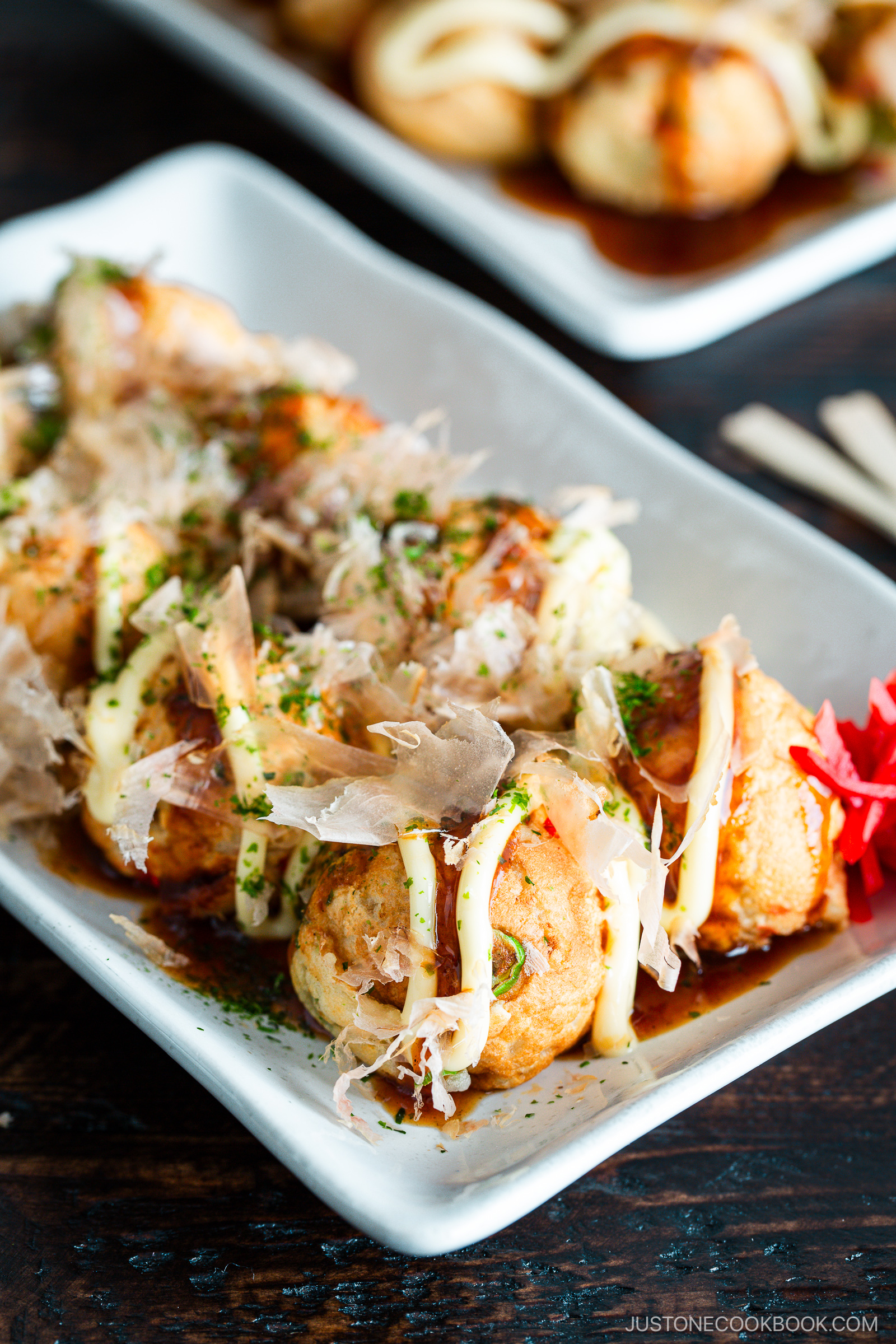
Takoyaki is a staple Japanese snack of little round balls stuffed with pieces of boiled octopus. It’s fun to cook these grilled dumplings with family and friends around a special tabletop grill. For my Takoyaki recipe, I’ll share the tips I’ve discovered from years of preparing these grilled octopus balls, including several delicious variations!
If you’re hungry for more Japanese street food recipes, try my Yakisoba, Okonomiyaki, or Hiroshima-style Okonomiyaki next!
Table of Contents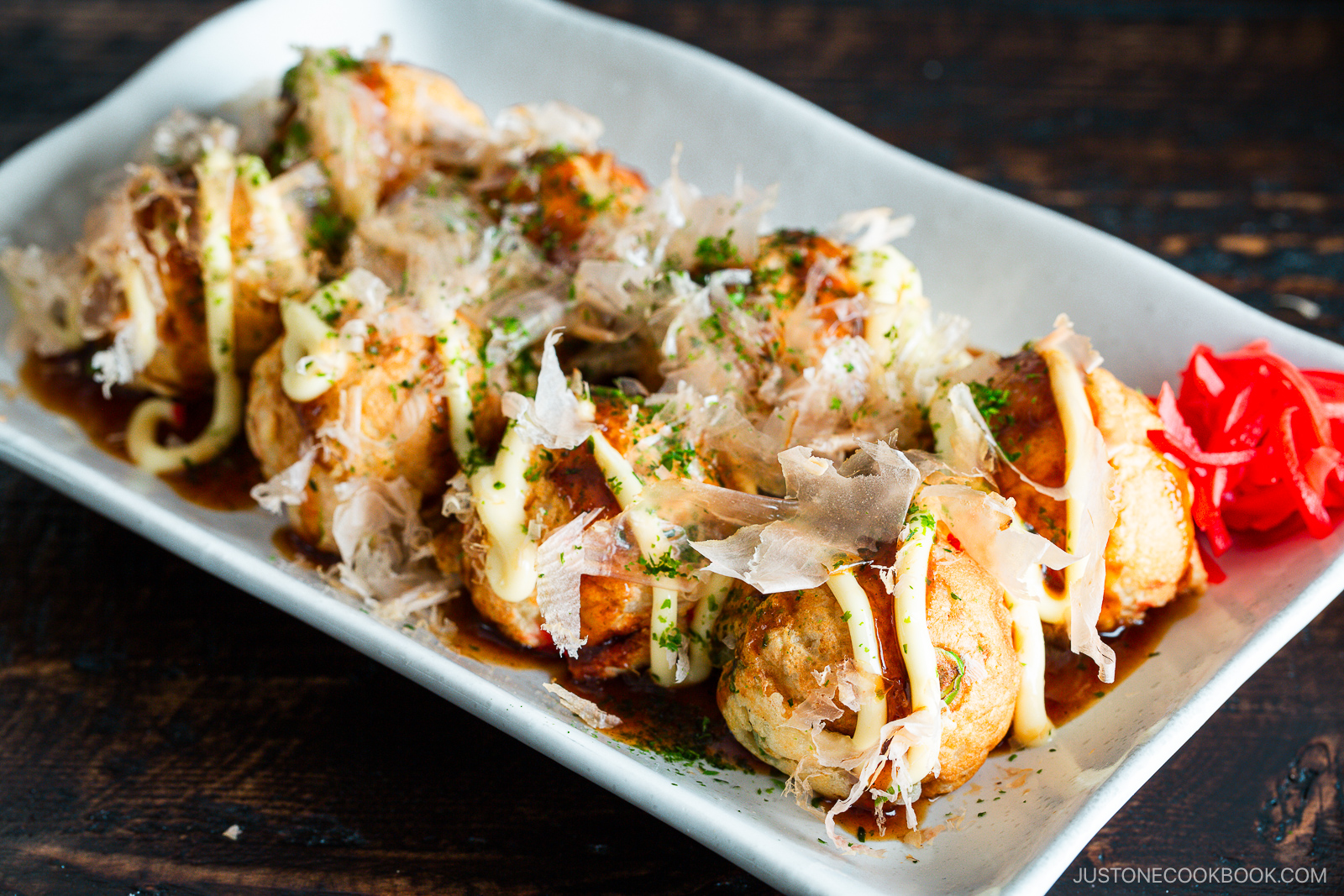
What is Takoyaki?
Takoyaki (たこ焼き, also tako-yaki) is a Japanese street food that originated in Osaka around 1935 before spreading to greater south-central Japan. It’s now synonymous with Osaka cuisine. You will typically find it sold by street vendors, convenience stores, and specialty restaurants. It is usually served with slightly salty takoyaki sauce and pairs perfectly with beer and other Japanese gastropub (izakaya) fare.

Why I Love This Recipe
- The perfect combination of textures – The boiled octopus is tender and chewy, while the dough is pillowy soft in the center and crispy on the outside.
- Easy to modify – The traditional recipe uses octopus, but you can easily substitute a variety of tasty fillings that I suggest below.
- Fun to make – I make it in a takoyaki pan that’s surprisingly fun and easy to use with some practice.
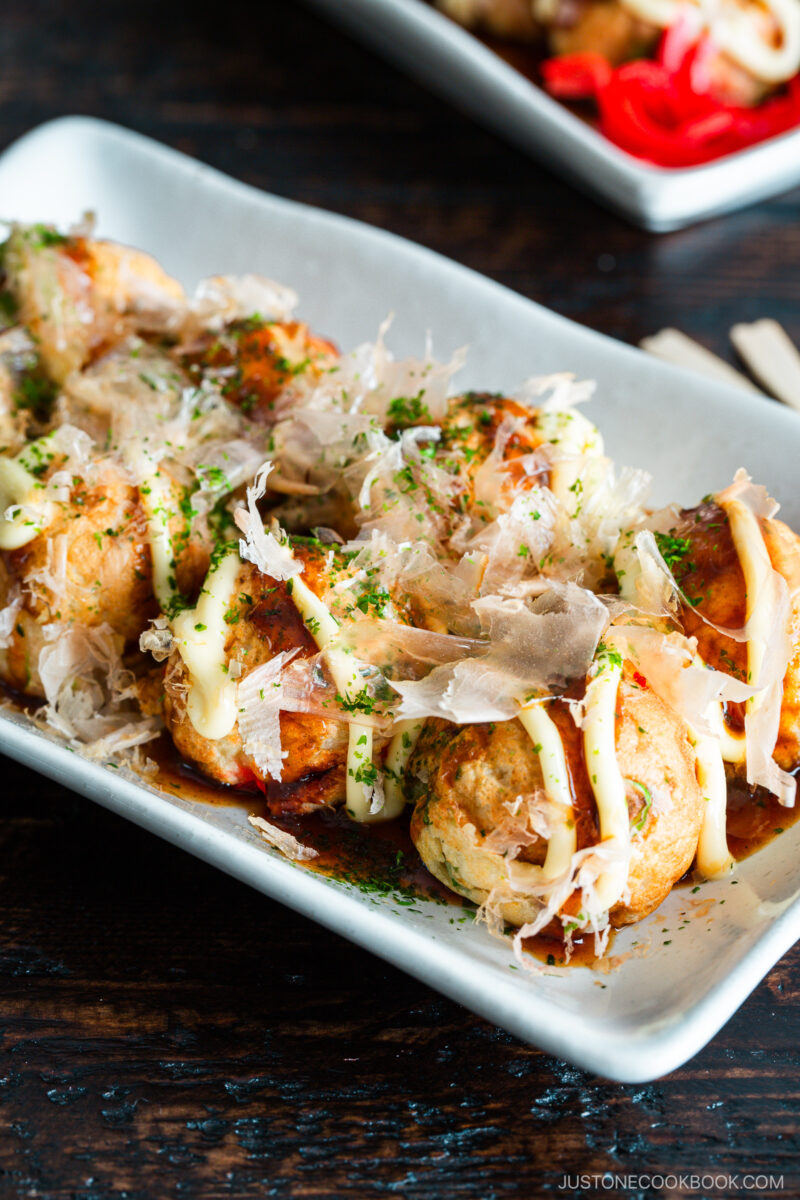
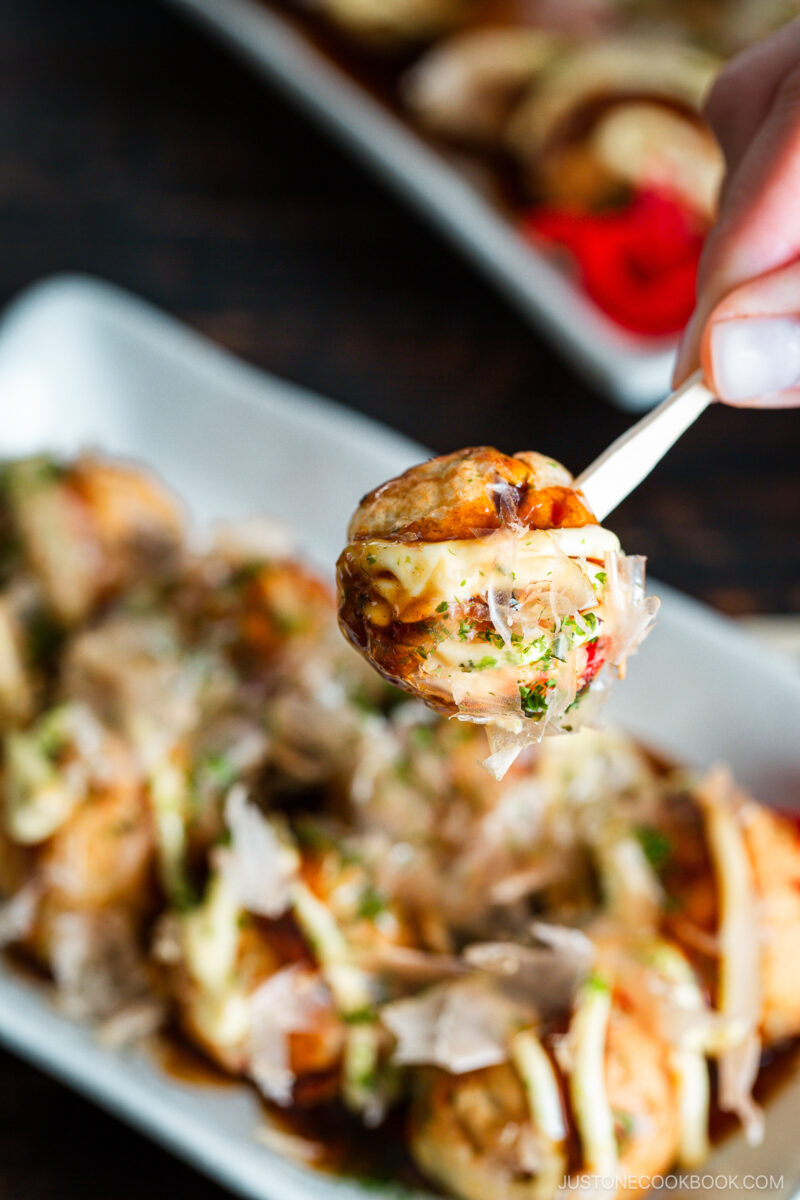
Ingredients for My Takoyaki Recipe
- Boiled octopus (sold as “octopus sashimi” at Japanese market)
- Katsuobushi (dried bonito flakes)
- Red pickled ginger (beni shoga)
- Tenkasu (tempura scraps) – store-bought or homemade Tenkasu
- Green onion/scallion
- Neutral oil
- Batter:
- All-purpose flour
- Baking powder
- Eggs
- Dashi (Japanese soup stock)
- Soy sauce
- Kosher salt
- Toppings:
- Takoyaki sauce – store-bought or homemade Takoyaki Sauce
- Japanese Kewpie mayonnaise
- Dried bonito flakes, aonori (dried green laver seaweed), and pickled red ginger
Find the printable recipe with measurements below.
Jump to RecipeSubstitutions
- Octopus (tako): You can find boiled octopus for sashimi at the seafood counter of a Japanese market. If you don’t have it, feel free to try one of the popular and delicious filling variations that I suggest below.
- Tenkasu: Also called agedama, these tempura scraps add an irreplaceable crunch and savory flavor. I can find it at my Asian grocery store, but if you can’t, try making your own tenkasu or use panko breadcrumbs.
- Soy sauce: Use tamari soy sauce for gluten free.
- Japanese mayonnaise: Made with egg yolks, this Kewpie mayo has a richer texture and flavor than standard mayonnaise. If you can’t find it, I suggest mixing 2 Tbsp rice vinegar and 1 Tbsp sugar into 1 cup of American mayonnaise. It won’t be the same, but it can work in a pinch.
- Takoyaki grill – These uniquely shaped pans are perfect for cooking small dough balls. I use a tabletop Zojirushi Electric Griddle and replace the flattop with a takoyaki plate.
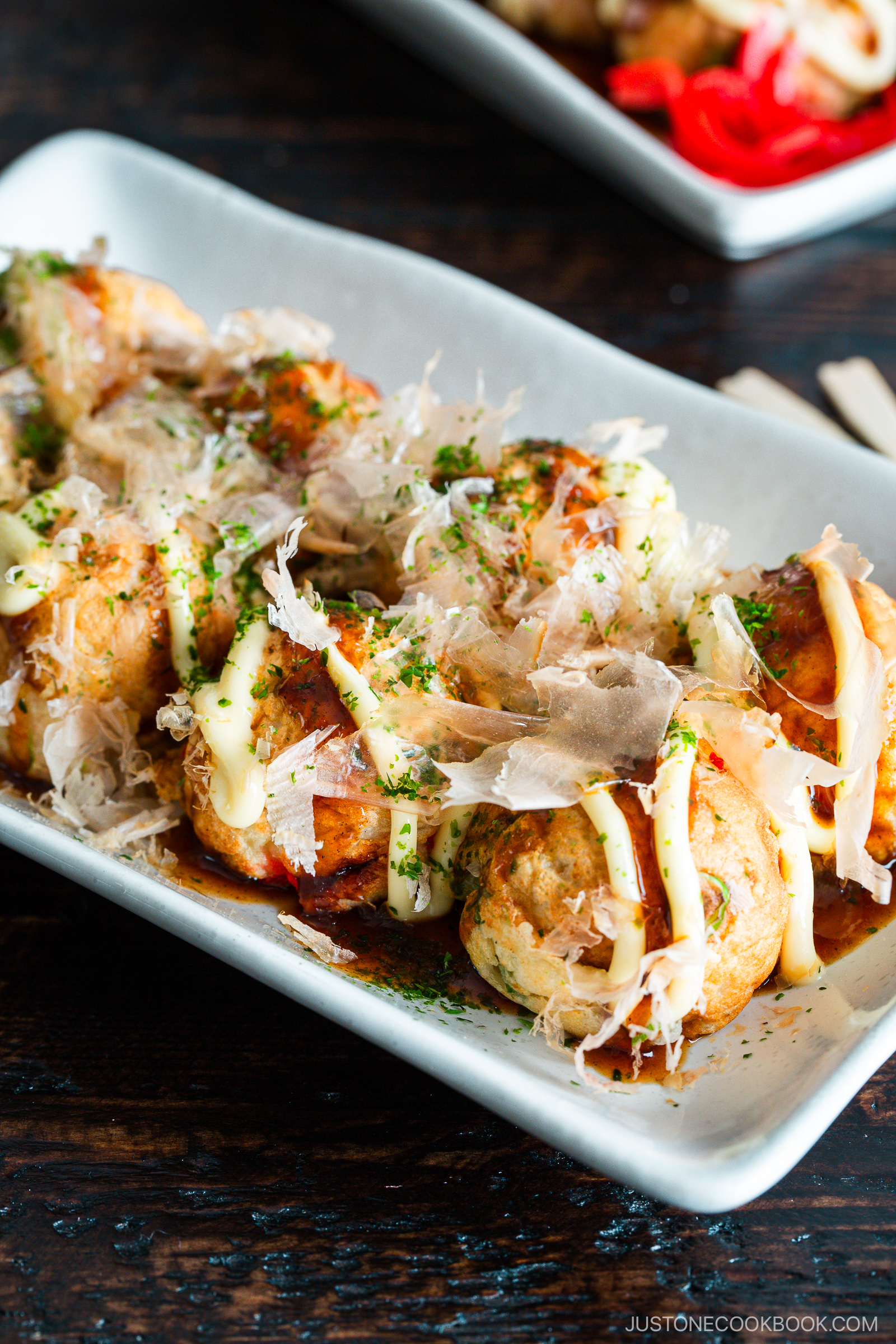
How to Make Takoyaki
Preparation
- Prep work. Grind the bonito flakes to a fine powder. Cut the scallions into fine slices, mince the pickled ginger, and cut the boiled octopus into bite-sized pieces.
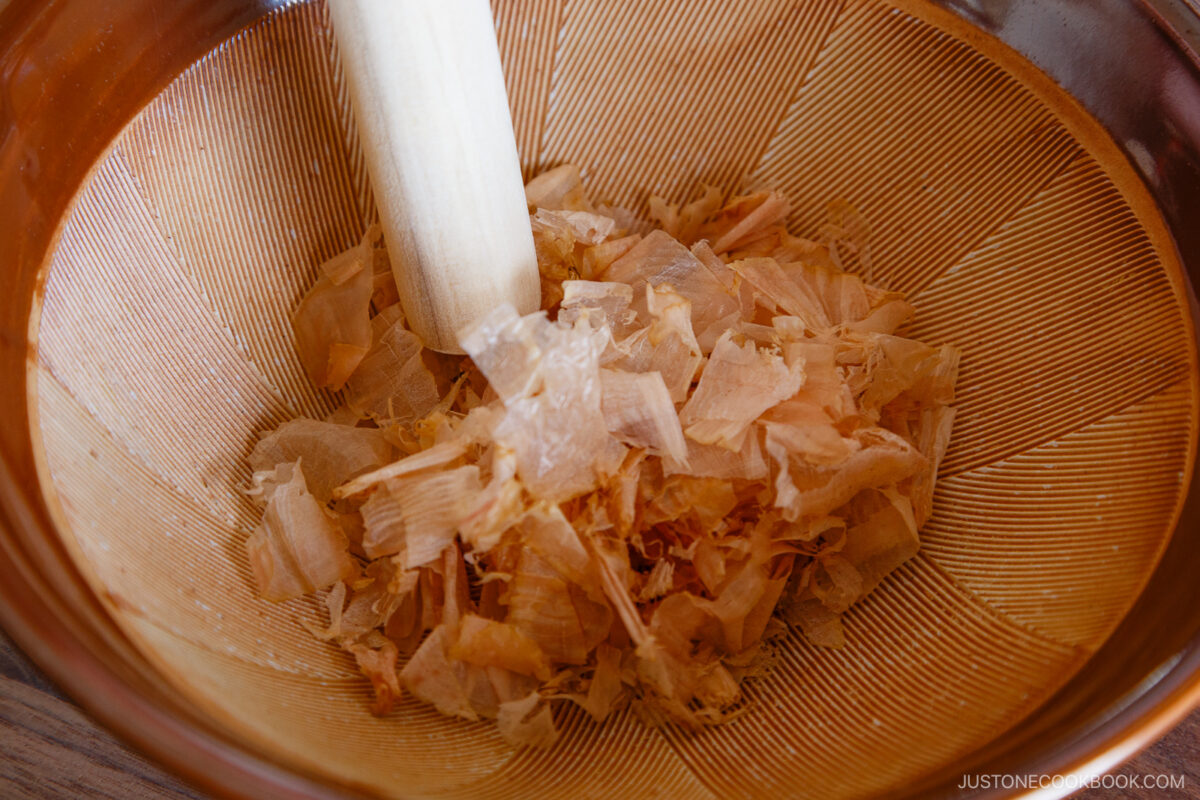
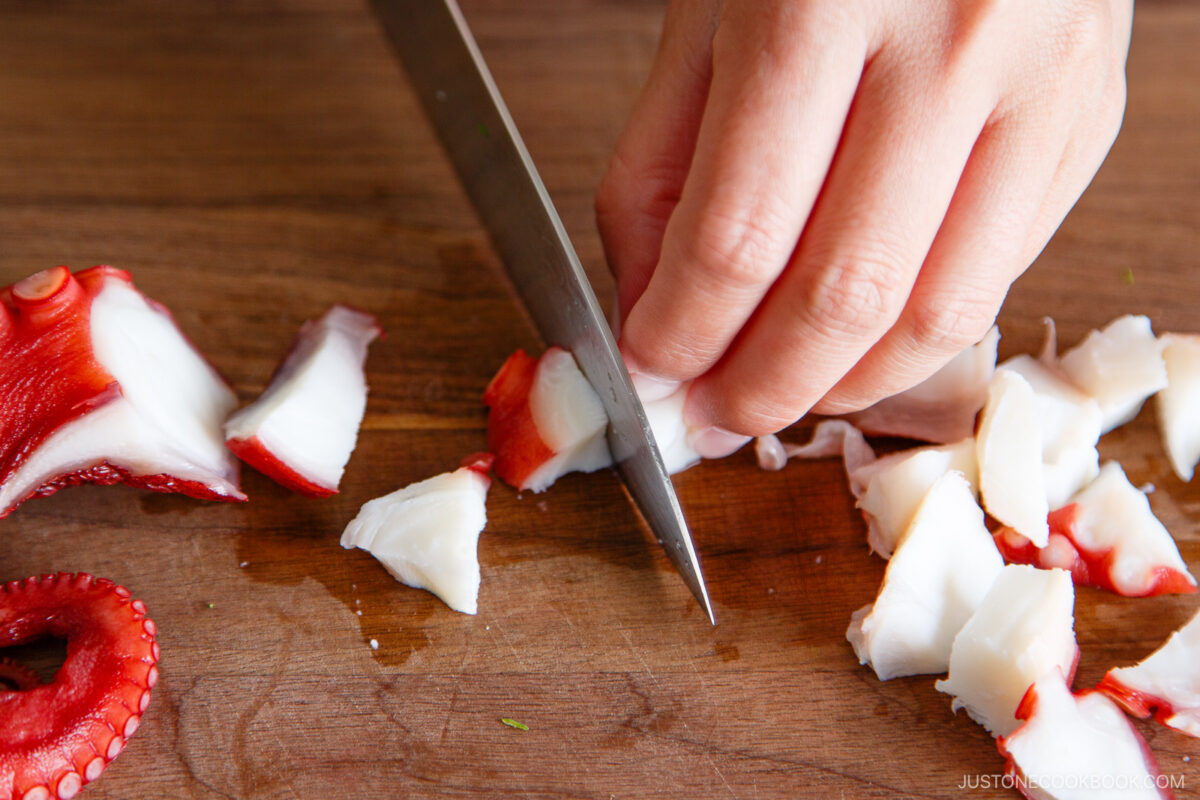
- Make the batter. Combine flour, baking powder, and salt in a large bowl. Add eggs, soy sauce, and dashi stock. Whisk until smooth.
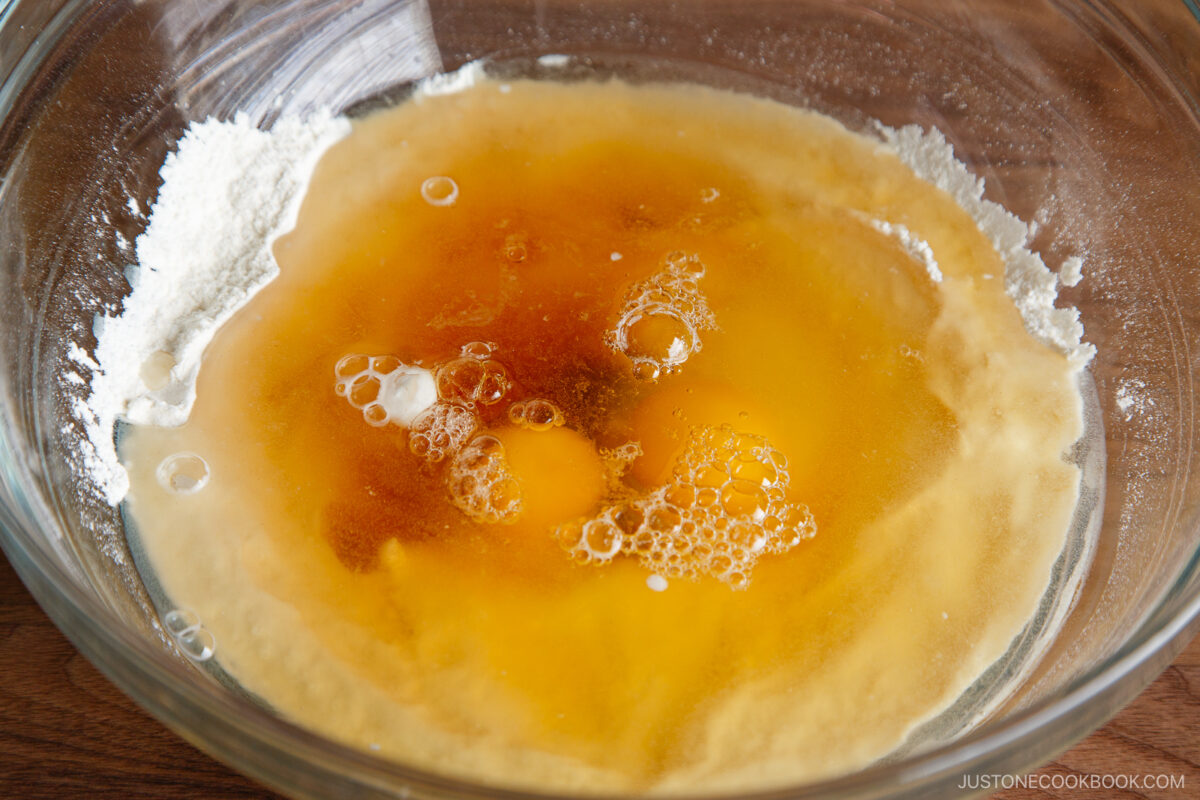
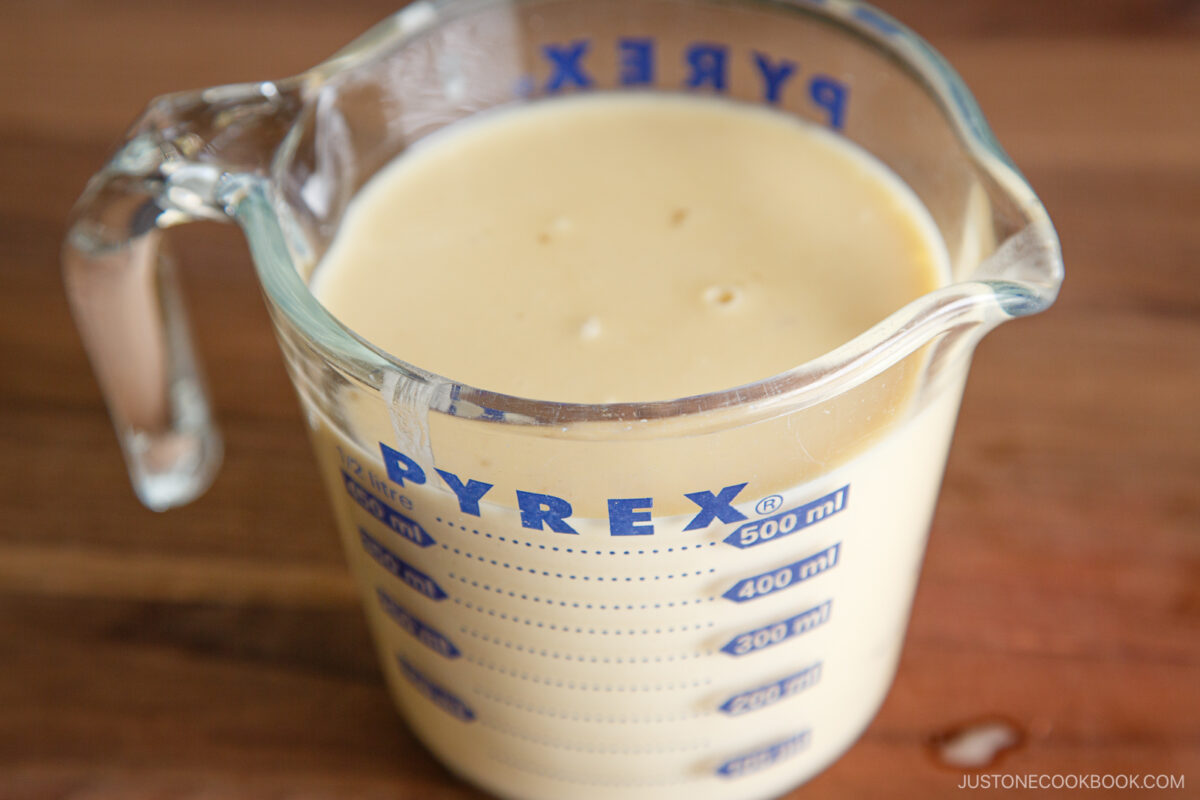
Cooking
- Pour the batter. Preheat the takoyaki pan and grease the round chambers with oil. Pour the batter into the hot chambers.

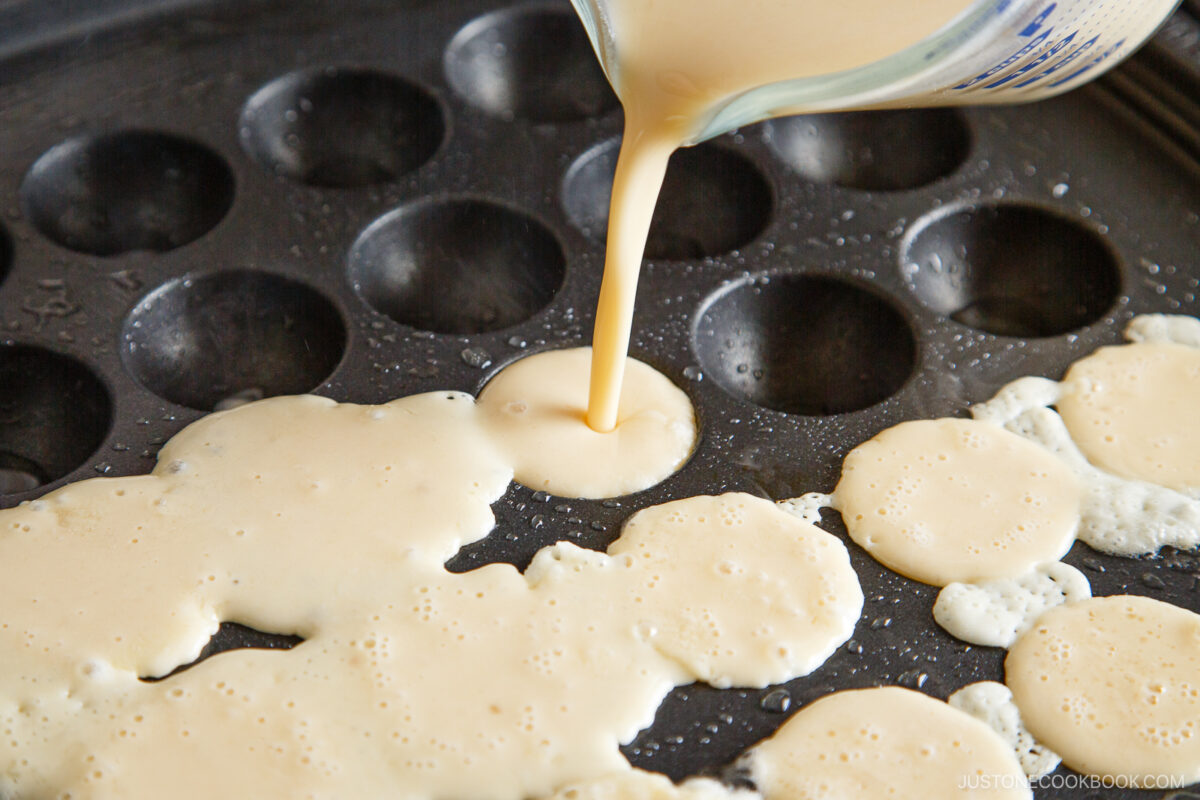
- Add octopus and cook. Place several octopus pieces in each chamber and sprinkle the katsuobushi powder, tenkasu, scallion slices, and red ginger on top.

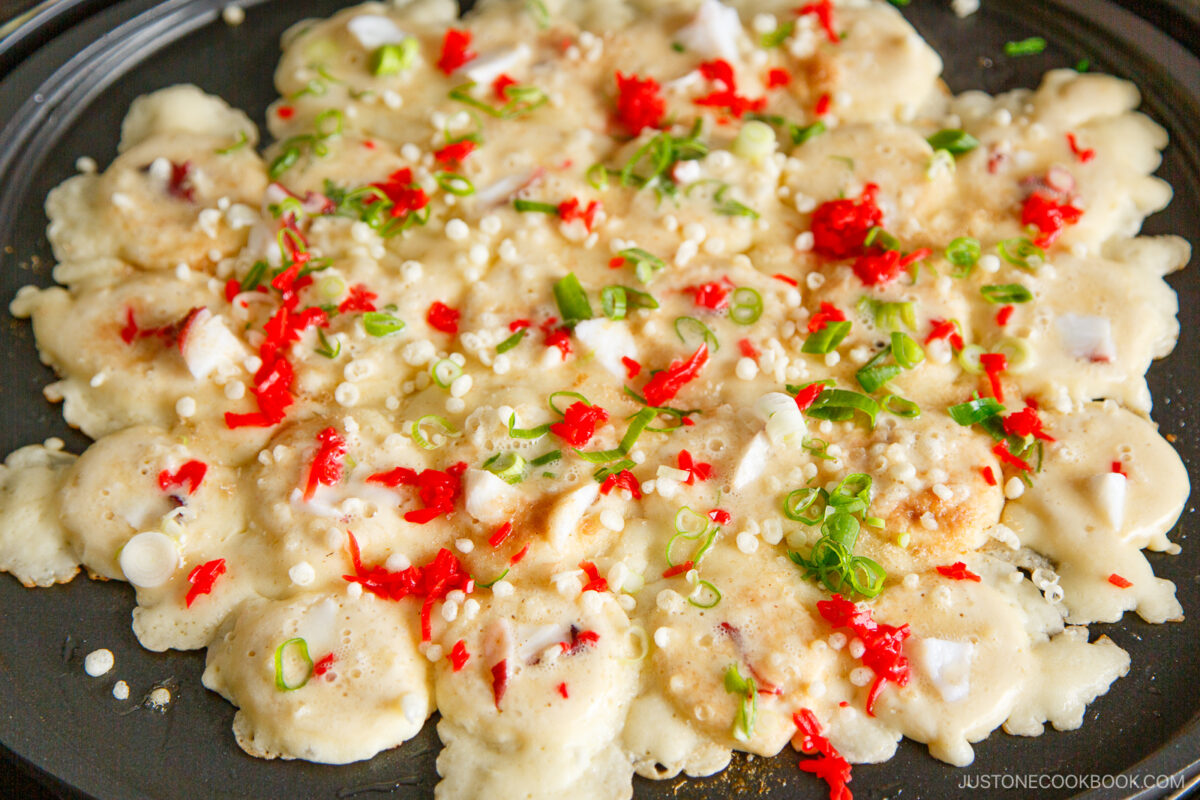
- Flip. Once the batter on the bottom is crisp, use skewers to break and rotate each piece 90 degrees toward the bottom of the pan. Continue cooking for 4 minutes. Turn each ball again to cook each side on the grill. Cook until crisp, then remove them from the grill.
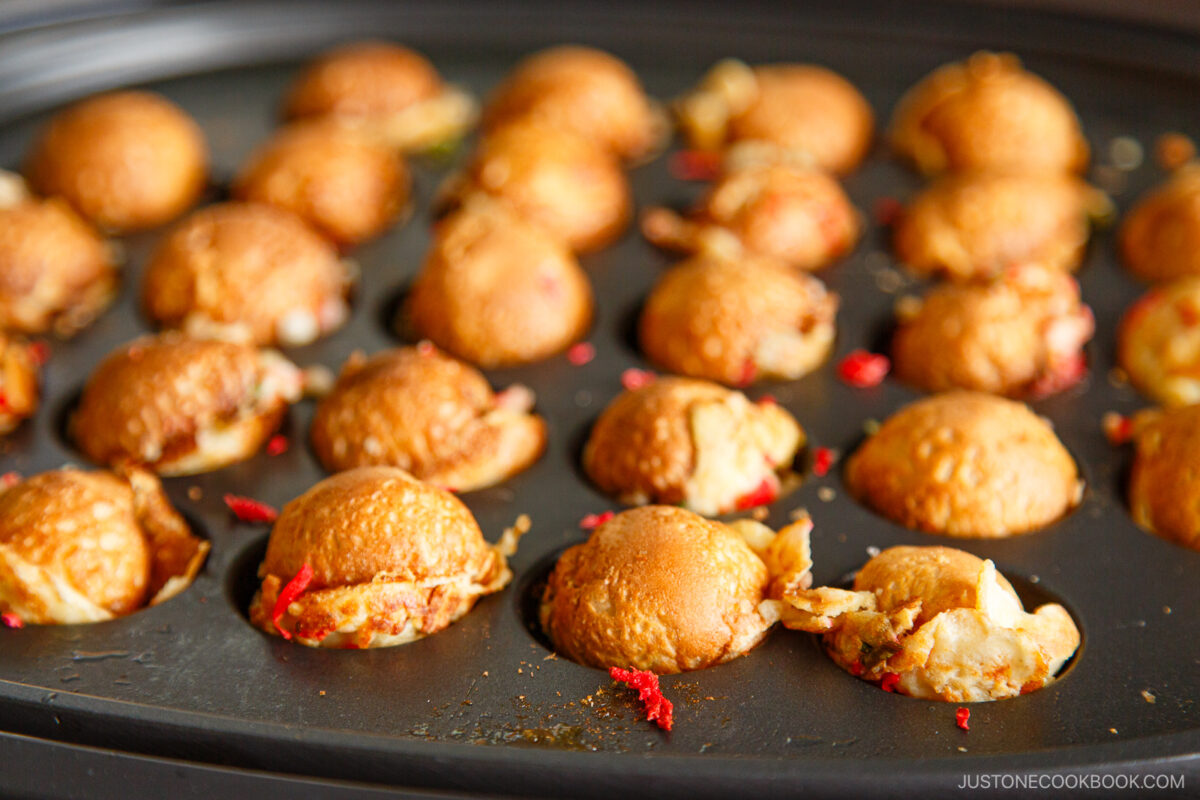
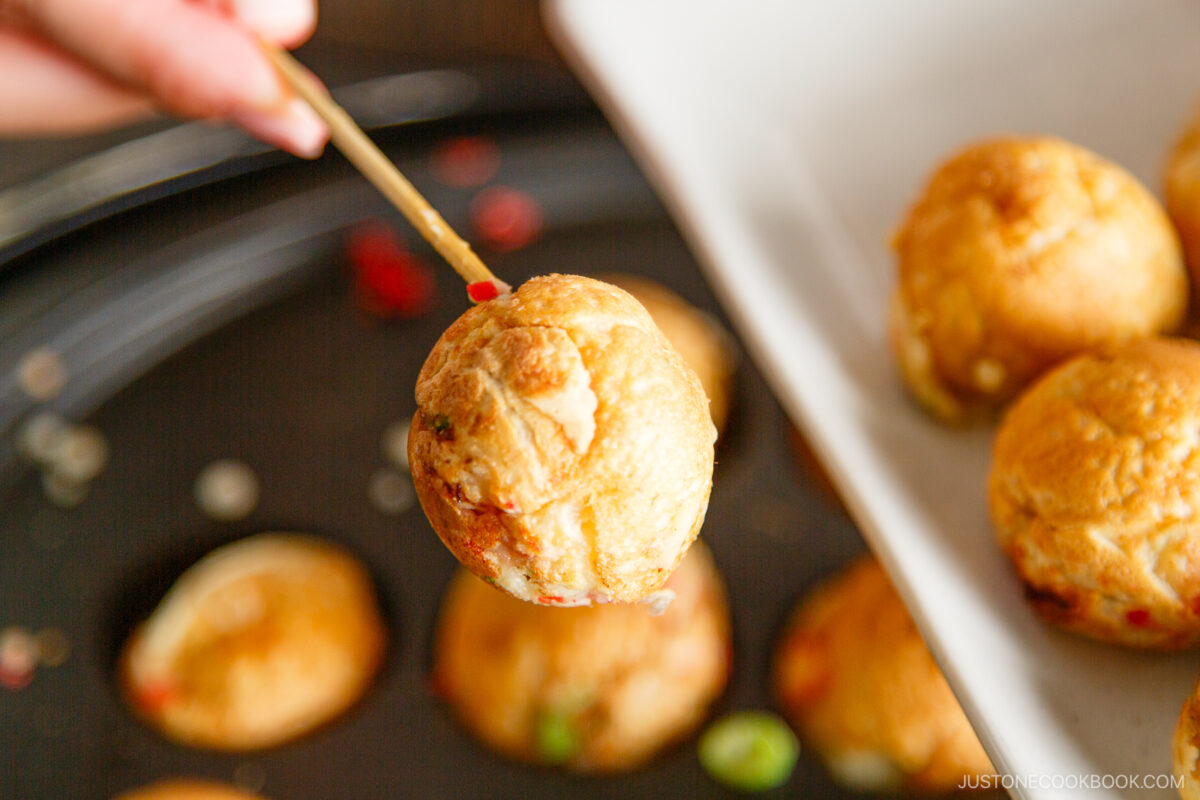
Assemble
- Garnish and serve. Transfer the octopus balls to a plate and drizzle with takoyaki sauce and Japanese mayo. Sprinkle katsuobushi and aonori and serve with pickled ginger. Serve immediately and enjoy!
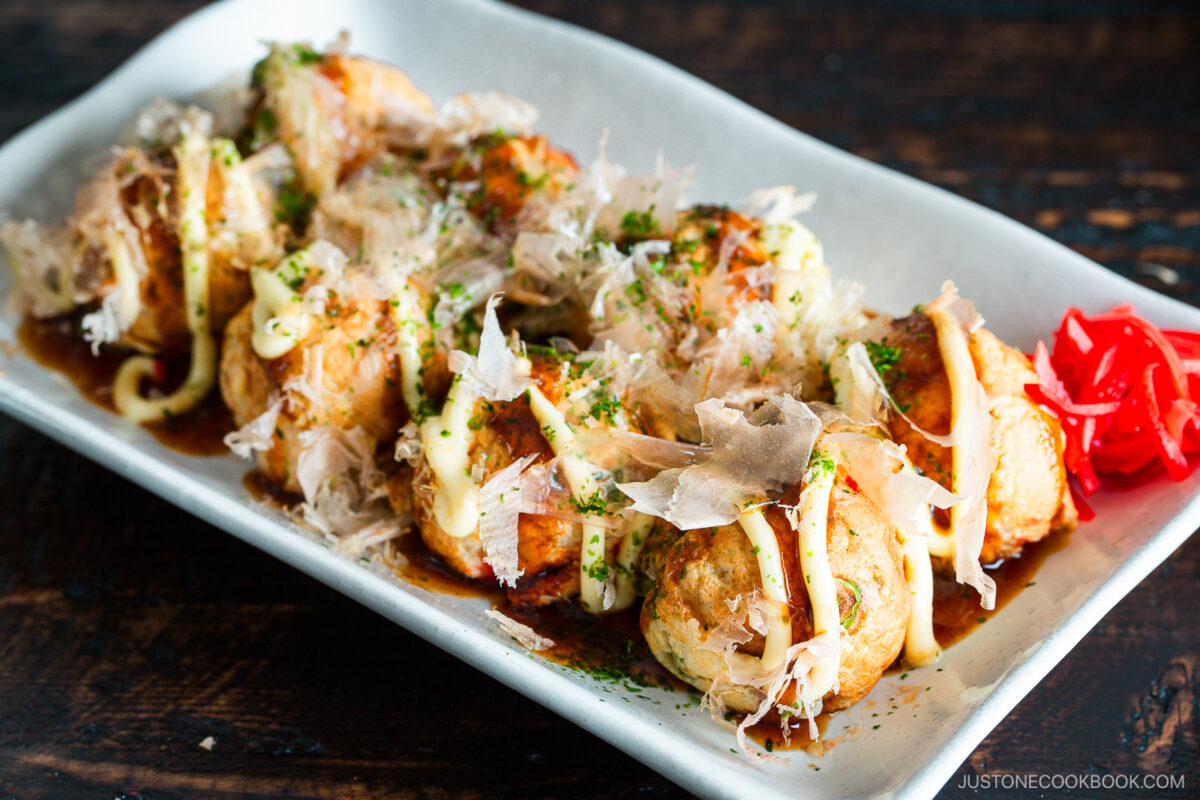
Nami’s Recipe Tips
- Pre-make the batter – When I’m short on time, I often make the batter the night before and store it (covered) in the refrigerator.
- Use a lot of oil to grease the pan – It’s the oil that will help the balls become extra crispy and golden.
- Don’t worry if the batter overflows – The round chambers are so small that it’s impossible not to overflow them, especially as you add especially as you add each piece of octopus filling.
- Keep turning the balls – Household takoyaki pans aren’t very good at distributing heat evenly, making the octopus balls prone to burning. Continuously flip them so all sides cook to an even golden brown.
- Stuff in the extra batter – Once the bottom is crispy, rotate 90 degrees to let the uncooked batter pour out into the chamber. Stuff the extra surrounding dough inside to help make a round ball shape.
Variations and Customizations
Don’t like octopus? No problem! Japanese children and adults alike often change things up by adding different fillings in this takoyaki recipe. Here are my favorite suggestions.
Comforting:
- Cheese – cheddar, mozzarella
- Corn & cheese – kids favorite
Meaty:
- Chopped sausage or hot dog – easy; I like Japanese kurobuta sausage
- Cooked chicken or pork belly – tender and satisfying
Seafood:
- Mentaiko (spicy cod/pollock roe) + mochi + cheese – love this combo!
- Boiled shrimp or caramari – a lighter seafood twist, but do not overcook it.
- Fish cake (chikuwa/crab sticks)
- Canned tuna
Plant-based:
- Corn
- Edamame
- Mochi (rice cakes)
- Kimchi – Adds tang and a bit of spice
- Pickled red ginger (beni shoga) and green onions – add more.
What to Serve with Takoyaki
- Vegetable sides – Green salad with Carrot Ginger Dressing makes a wonderful palate cleanser.
- A la carte small plates – Serve it with a variety of sharable snacks like Karaage (Japanese fried chicken).
- Street food – Pair takoyaki with Crispy Taiyaki and Mitarashi Dango for a street food experience.
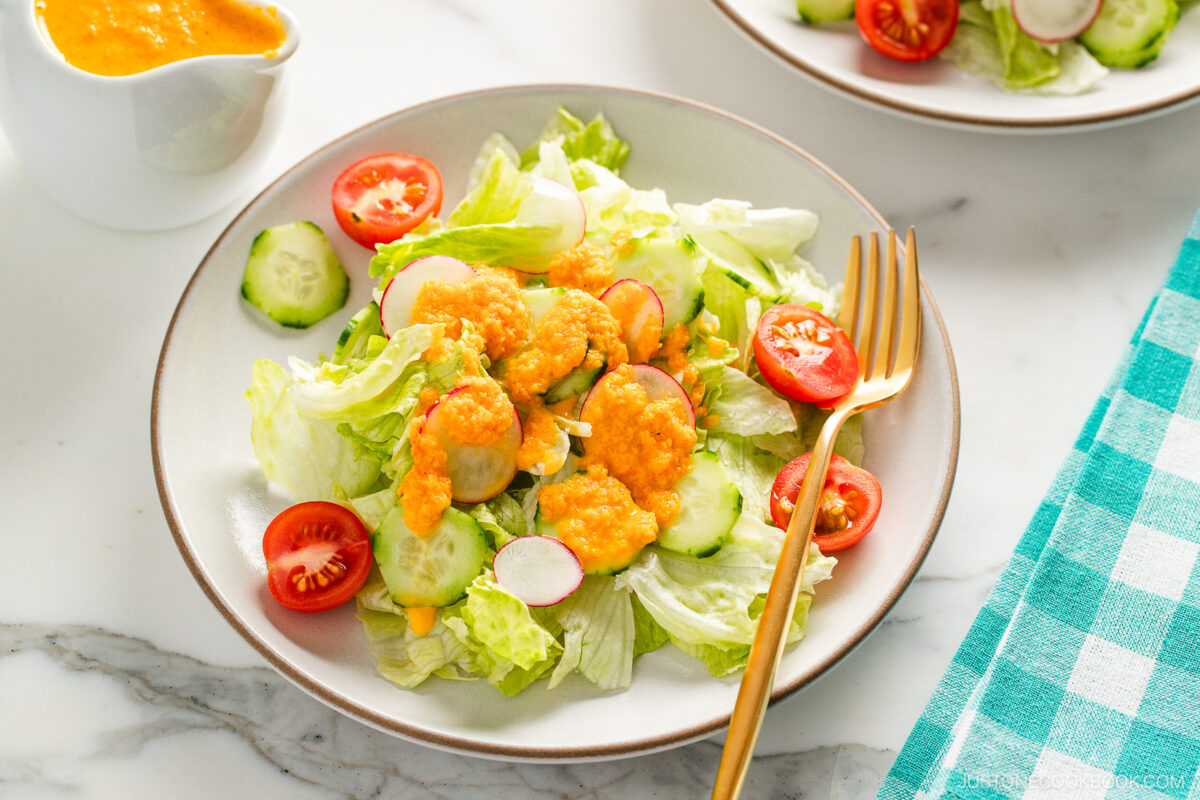
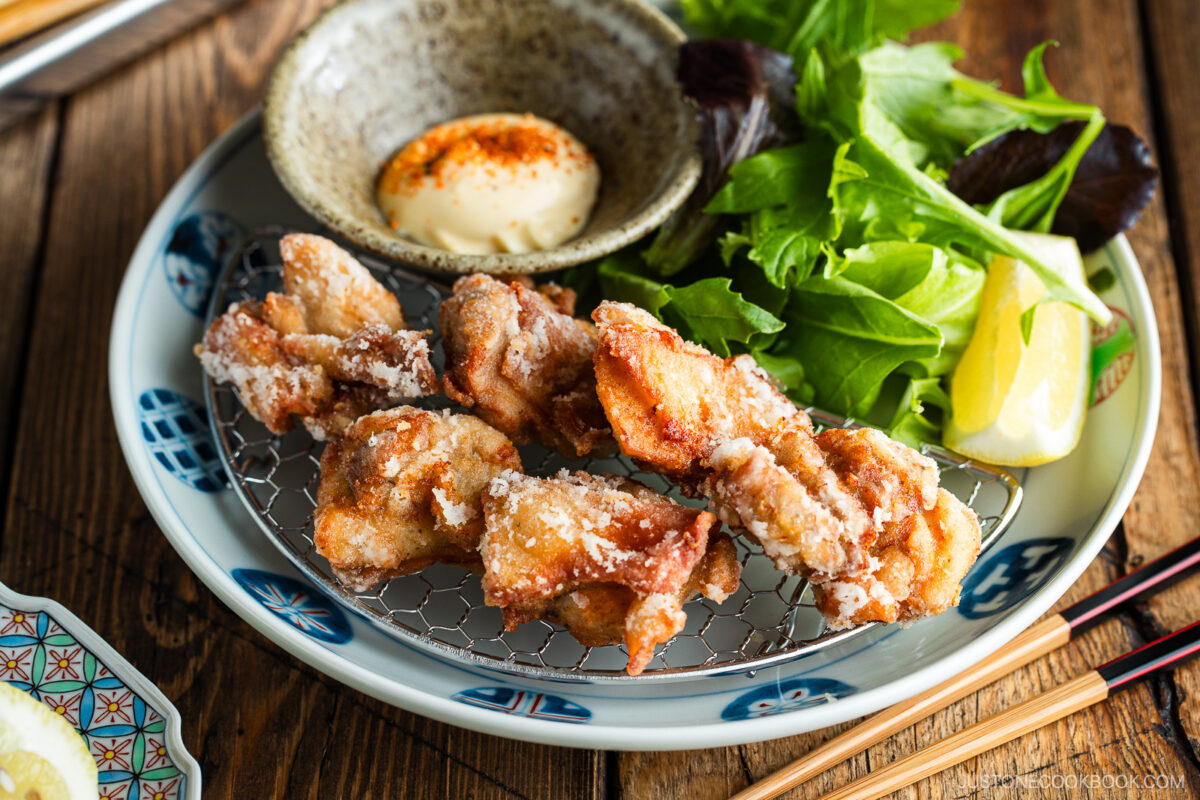
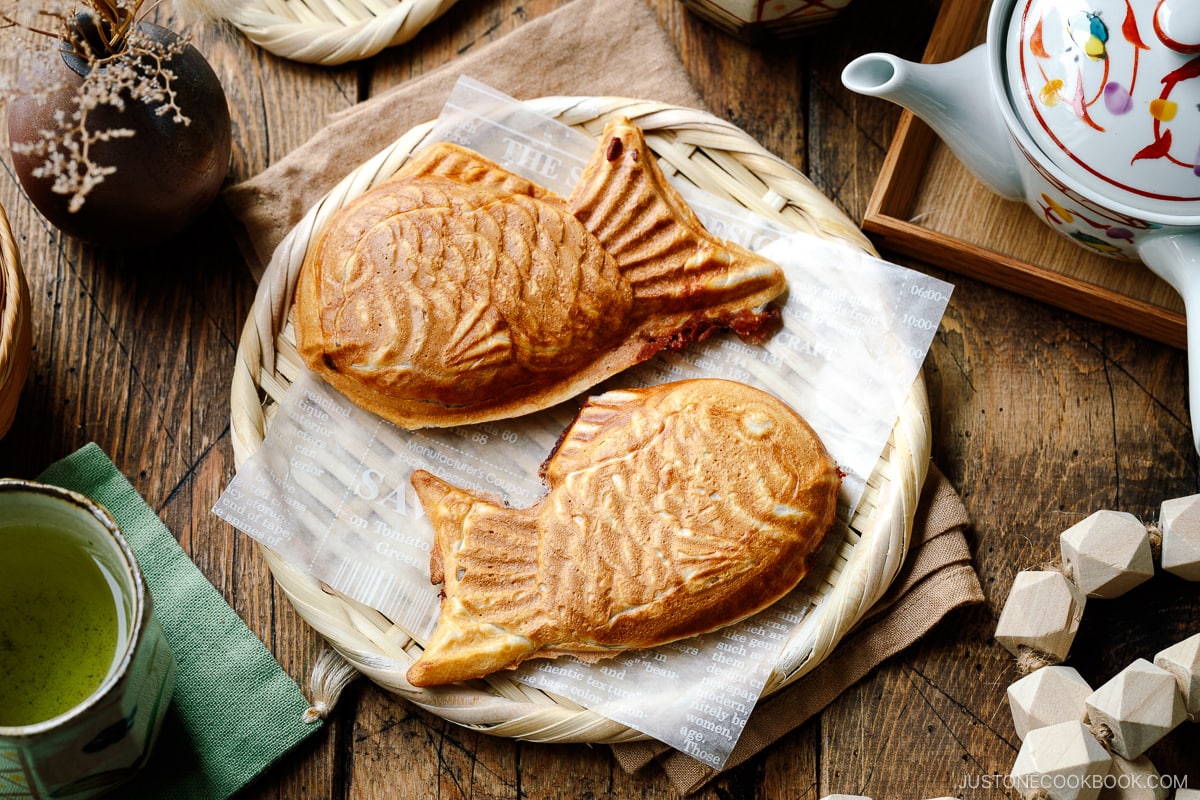
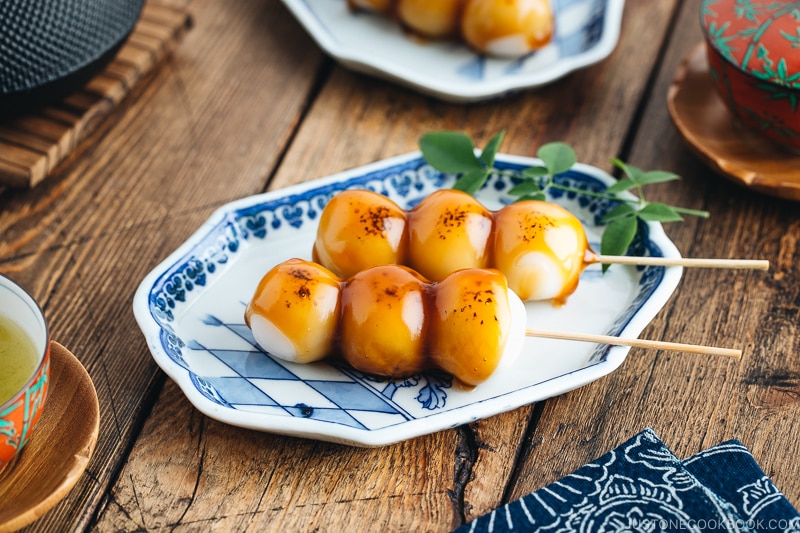
Storage and Reheating Tips
To store: Store leftovers in an airtight container in the refrigerator for 3 days or in the freezer for 2–3 weeks.
To reheat: Reheat leftovers in the oven at 350ºF (180ºC) for 8–10 minutes if defrosted or 12–15 minutes if frozen.
Frequently Asked Questions
Can I use a different filling for takoyaki instead of octopus?
While octopus is the standard filling, it is not the only way to serve takoyaki. You can make this takoyaki recipe by swapping out the filling; popular choices include shrimp, squid, mushrooms, or cheese. See my suggested fillings above for more ideas.
Gather all the ingredients.
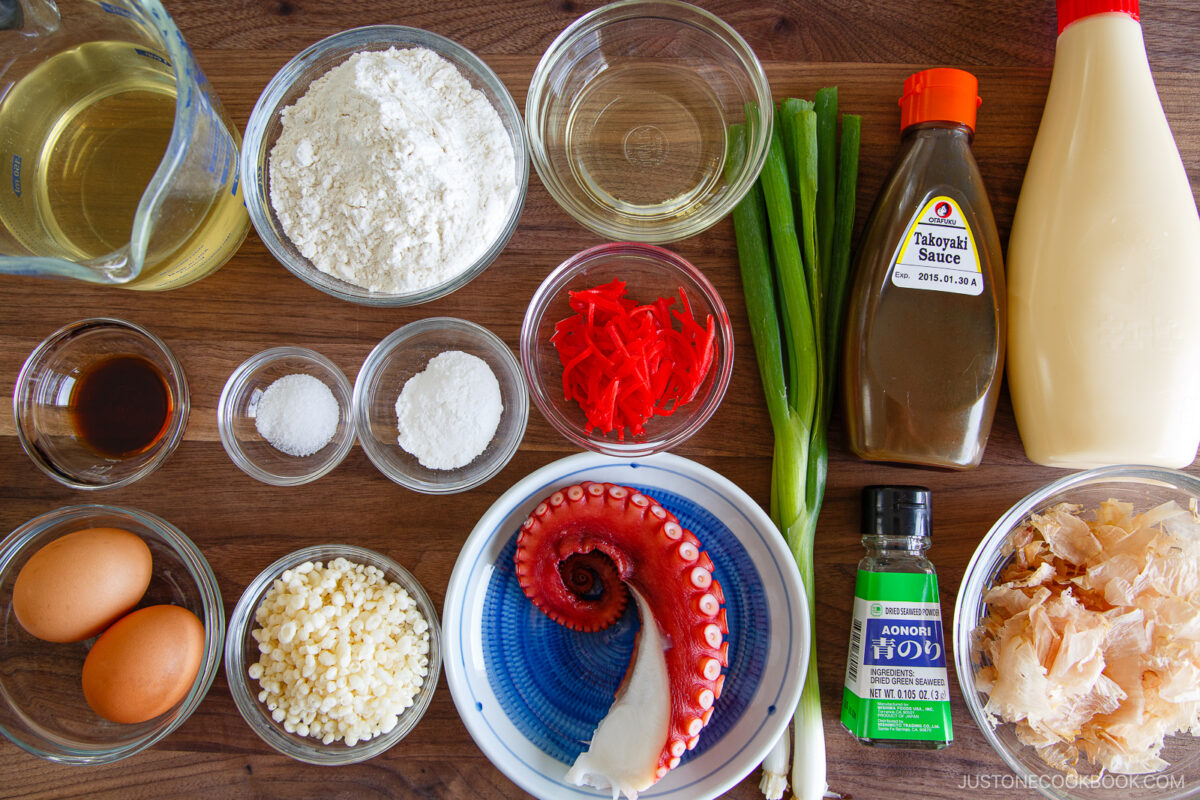
To Prepare the Filling
Grind ¼ cup katsuobushi (dried bonito flakes) into a fine powder. Set aside to use during cooking.
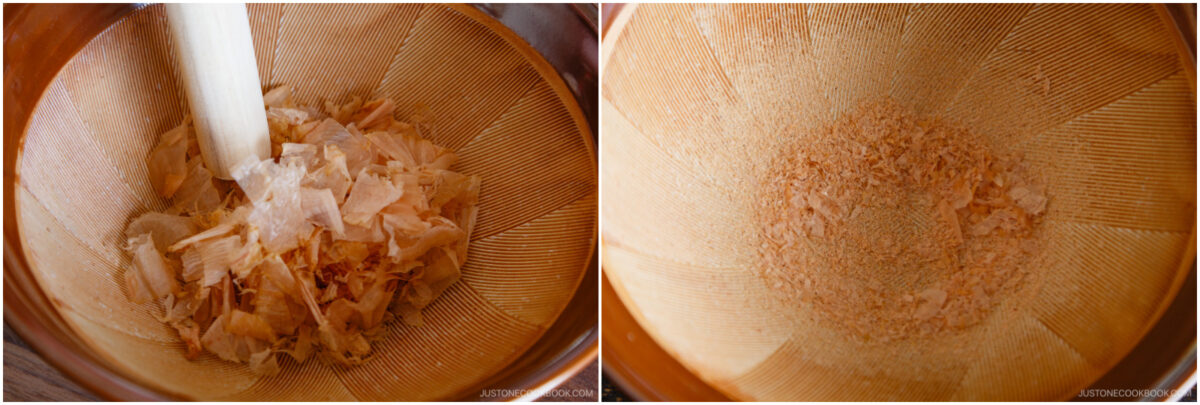
Cut 2 green onions/scallions into thin slices and mince 1 Tbsp pickled red ginger (beni shoga or kizami beni shoga). Cut 4.2 oz octopus sashimi (boiled octopus) into bite-sized pieces about ½ inch (1.3 cm); I use the rangiri cutting technique. Tip: Cut it into smaller pieces so it's easier to chew, especially for kids.
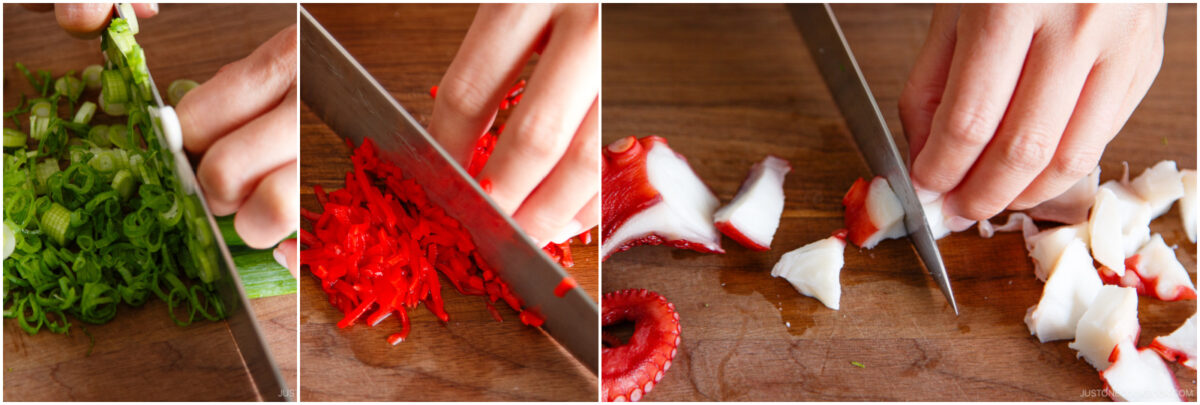
To Make the Batter
Combine 1 cup all-purpose flour (plain flour), 2 tsp baking powder, and ½ tsp Diamond Crystal kosher salt in a large mixing bowl. Whisk it all together.
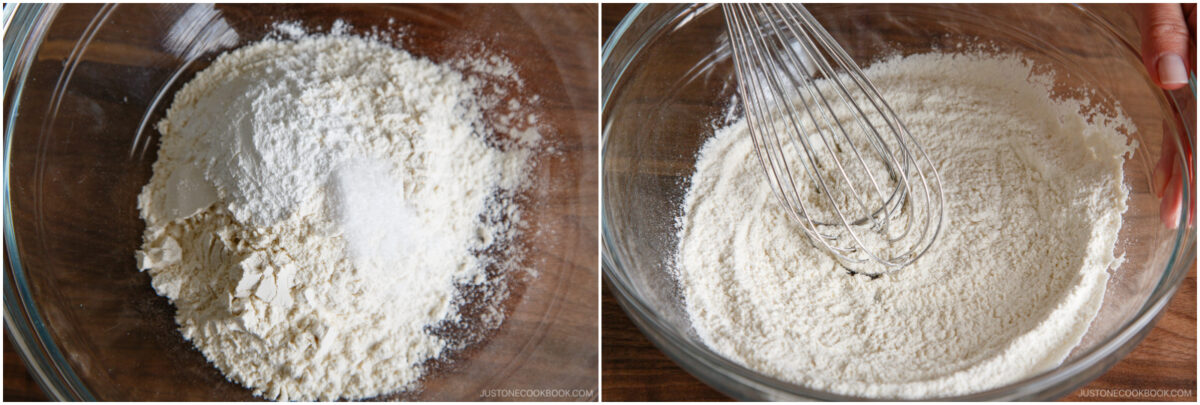
Add 2 large eggs (50 g each w/o shell), 1 tsp soy sauce, and 1½ cups dashi (Japanese soup stock) to the bowl.
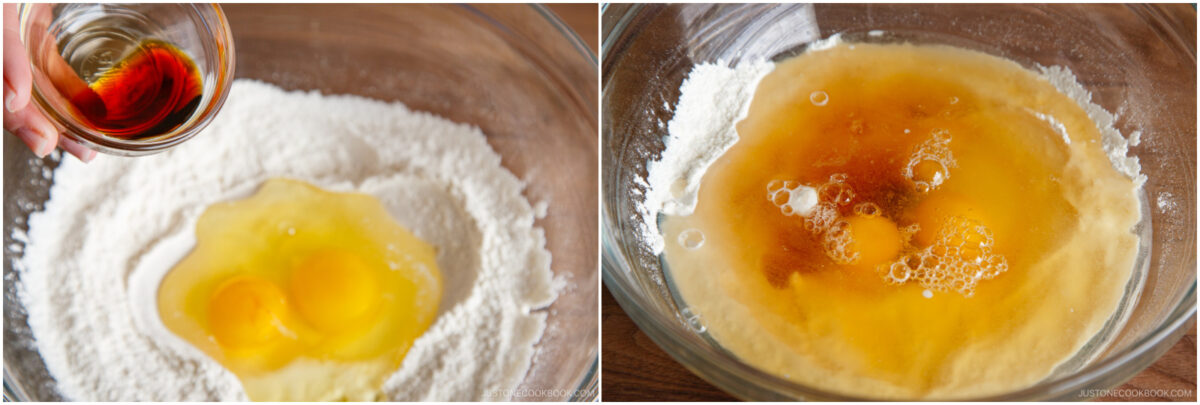
Whisk until well blended. Transfer it to a handled measuring cup or any pitcher with a spout for easy pouring.
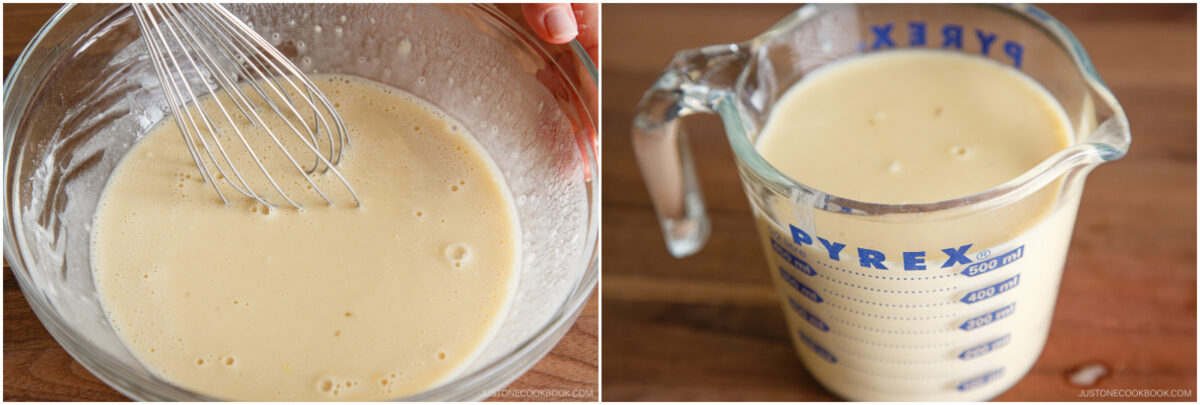
To Cook the Takoyaki
Heat the takoyaki pan to 400ºF (200ºC) over medium heat. Use a brush to generously grease the rounded chambers and flat top surface with 2 Tbsp neutral oil. When the oil starts to smoke, pour the batter to fill the chambers. It’s okay to slightly overfill the cavities. In the next steps, the batter will likely overflow as you add more ingredients to it.
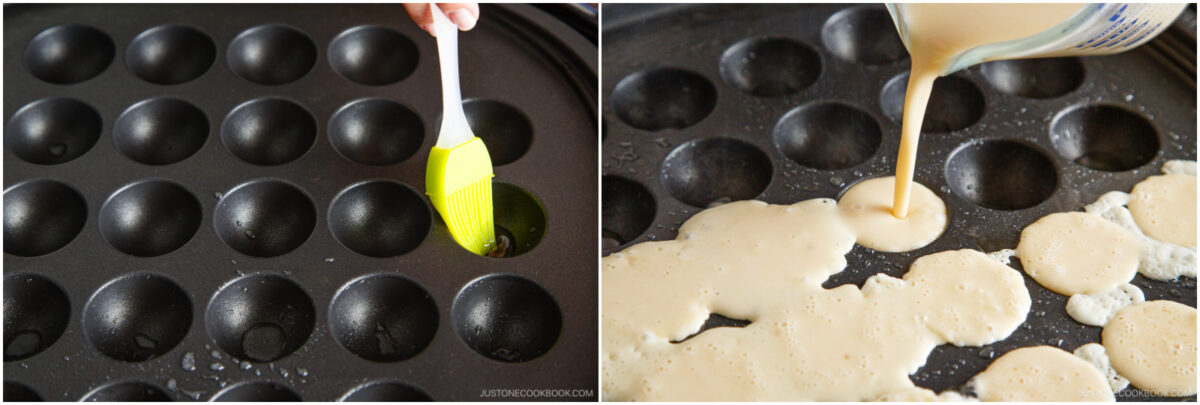
Add 1–3 octopus pieces, depending on their size, to each chamber and sprinkle the ground katsuobushi powder on top.
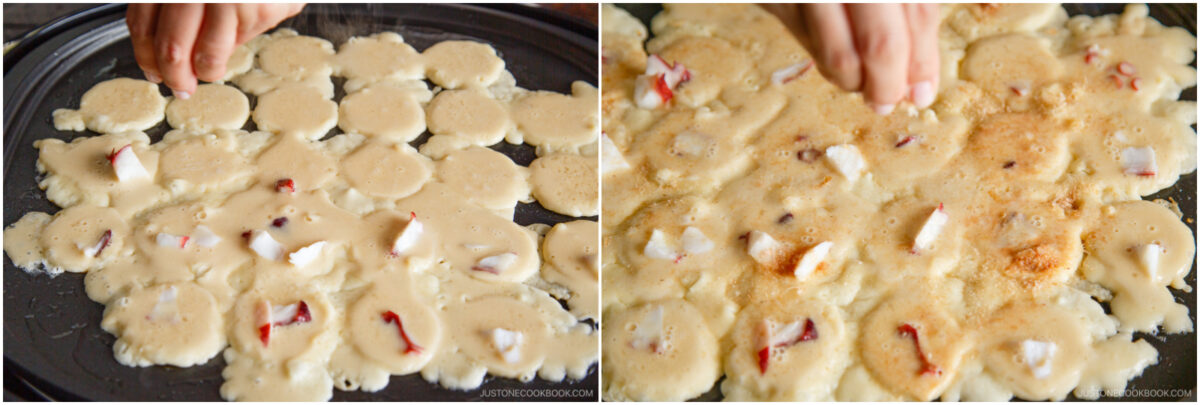
Sprinkle ⅓ cup tenkasu/agedama (tempura scraps), the green onion slices, and the chopped pickled red ginger on top. After 3 minutes or so, when the batter on the bottom has set and is slightly crisp, use skewers to break the connected batter on top between the chambers. Rotate each piece 90 degrees (a quarter turn) toward the bottom of the pan. Stuff the connected dough back into the ball as you turn; the uncooked batter will flow out from inside to create another side of the ball. After you finish turning them, set a timer for 4 minutes.
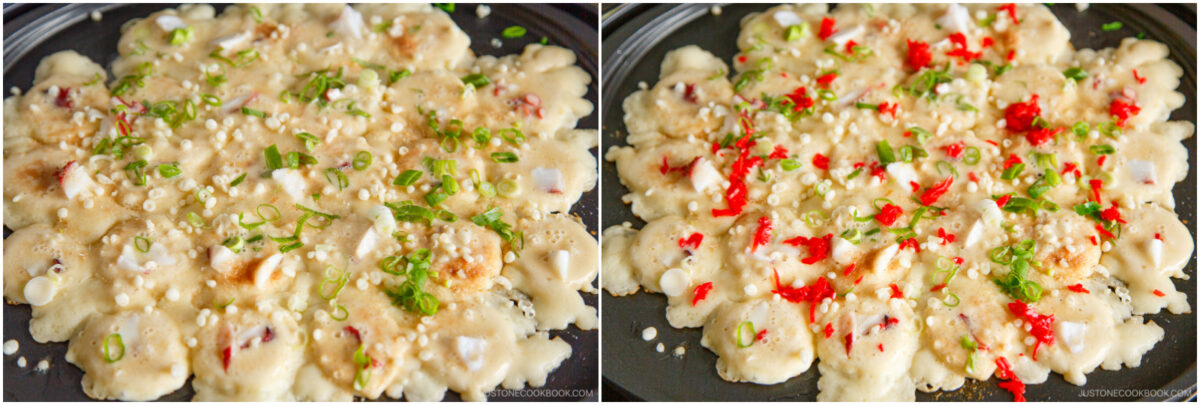
After 4 minutes, rotate them again, starting with the first ball. Turn each takoyaki another 90 degrees toward the bottom of the pan so the remaining uncooked batter pours out into the chamber to complete the ball shape. Home takoyaki griddles don‘t distribute heat evenly, so it’s a good idea to swap the balls around to different chambers so they brown evenly. After turning and cooking for another 4 minutes, they are done.
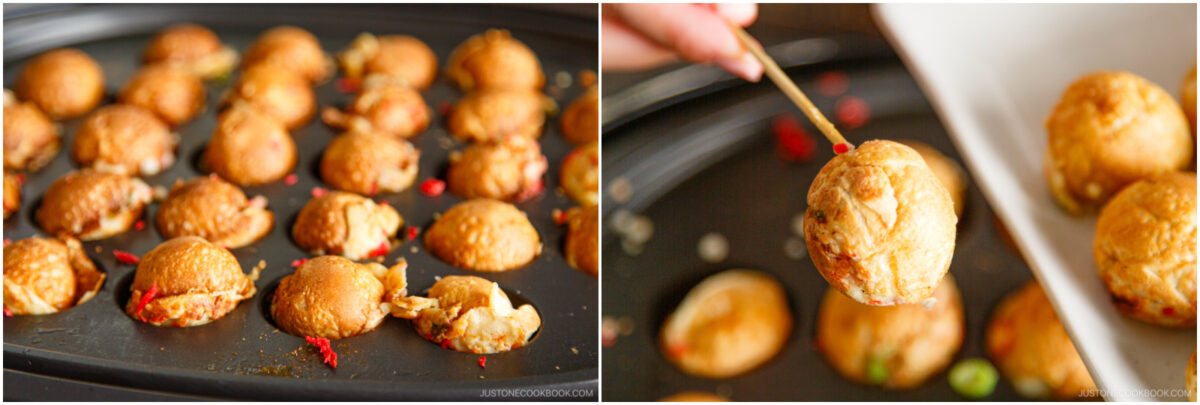
Take a look at how I flip the dumplings in this video—start watching from the timestamp where I start grilling.
To Serve
Transfer them onto a plate and drizzle with ½ cup takoyaki sauce and Japanese Kewpie mayonnaise. Sprinkle with katsuobushi (dried bonito flakes) and aonori (dried green laver seaweed) and serve with a side of pickled red ginger (beni shoga or kizami beni shoga). Serve immediately. (But, be careful—they‘re VERY hot inside!)
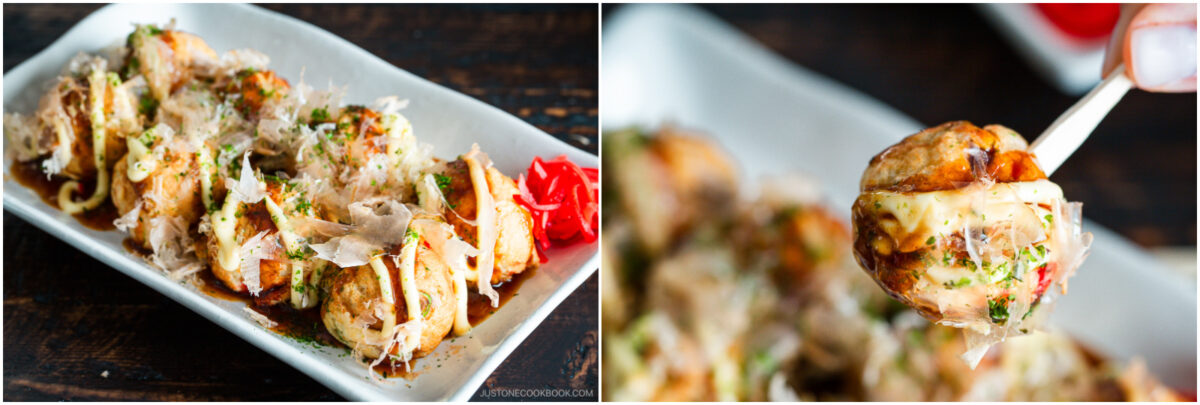
To Store
You can keep the leftovers in an airtight container and store in the refrigerator for 3 days or in the freezer for 2–3 weeks.
Variations and Customizations
Don’t like octopus? No problem! Japanese children and adults alike often change things up by adding different fillings in this takoyaki recipe. Here are my favorite suggestions.
Comforting:
- Cheese – cheddar, mozzarella
- Corn & cheese – kids’ favorite
Meaty:
- Chopped sausage or hot dog – I like Japanese kurobuta sausage
- Cooked chicken or pork belly
Seafood:
- Mentaiko (spicy cod/pollock roe) + mochi + cheese – love this combo!
- Boiled shrimp or caramari – do not overcook it.
- Fish cake (chikuwa/crab sticks)
- Canned tuna
Plant-based:
- Corn
- Edamame
- Mochi (rice cakes)
- Kimchi – Adds tang and a bit of spice
- Pickled red ginger (beni shoga) and green onions – add more
Calories: 51kcal, Carbohydrates: 5g, Protein: 2g, Fat: 2g, Saturated Fat: 1g, Polyunsaturated Fat: 1g, Monounsaturated Fat: 1g, Trans Fat: 1g, Cholesterol: 17mg, Sodium: 124mg, Potassium: 33mg, Fiber: 1g, Sugar: 1g, Vitamin A: 37IU, Vitamin C: 1mg, Calcium: 25mg, Iron: 1mg
Did you make this recipe?
Tag @justonecookbook on Instagram so we can see your delicious creation!
Editor’s Note: This post was originally published on October 20, 2013. It was updated with new images and a video on December 4, 2016, and republished on August 12, 2025.

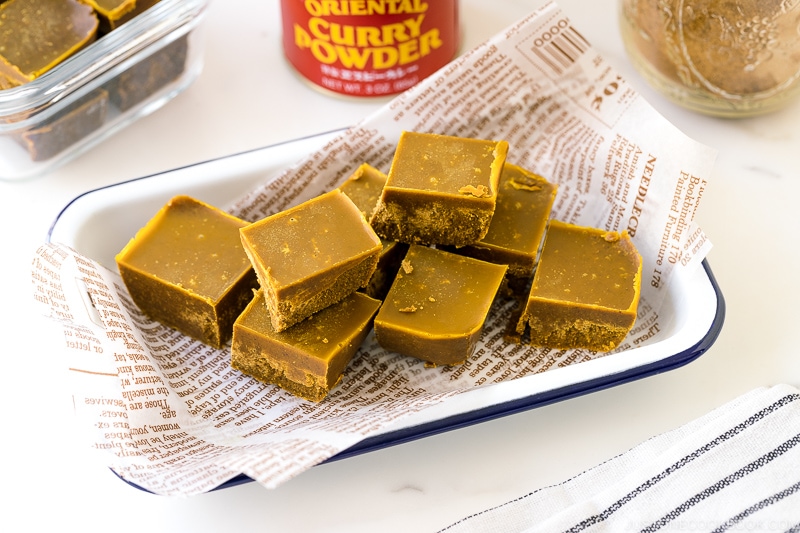





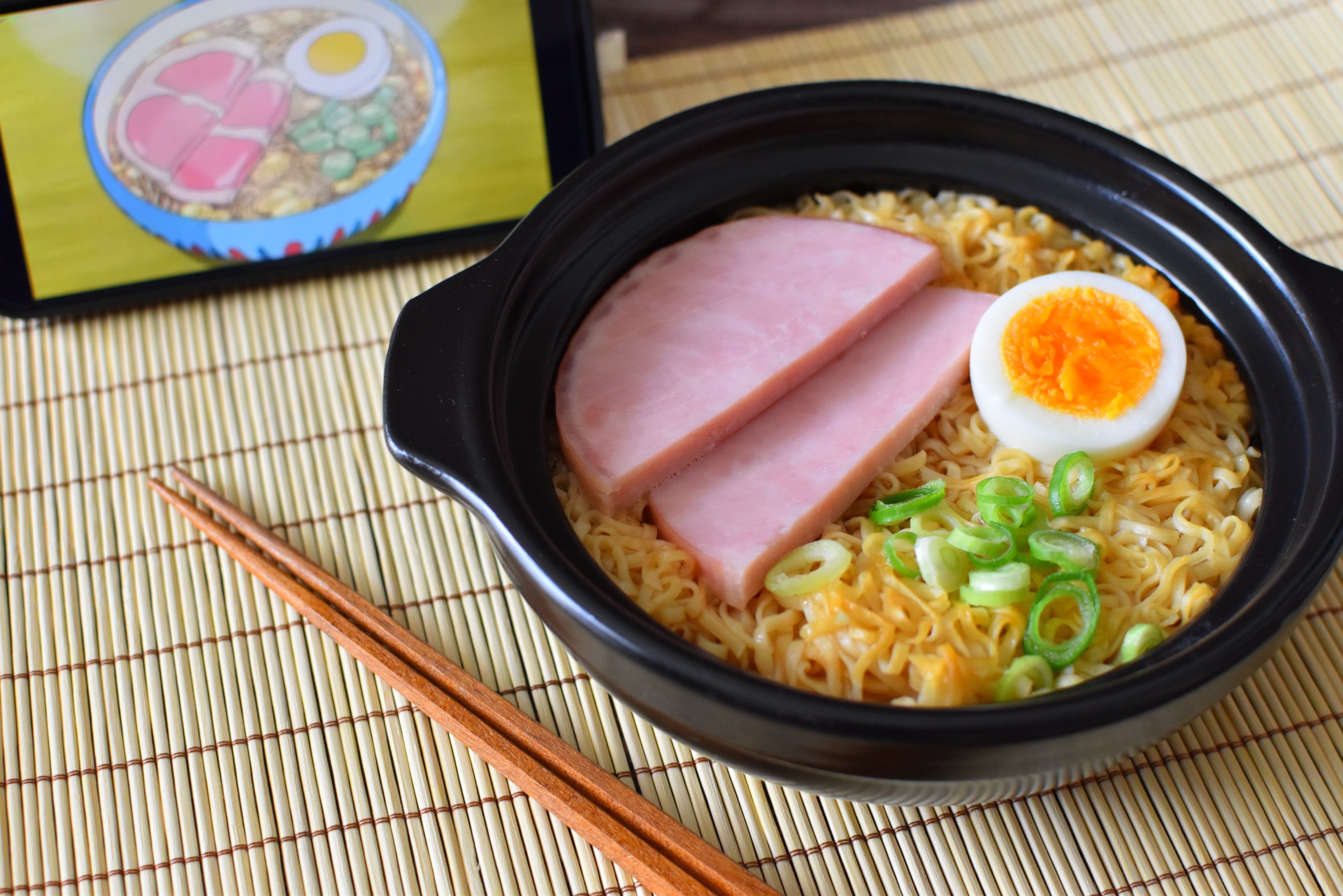
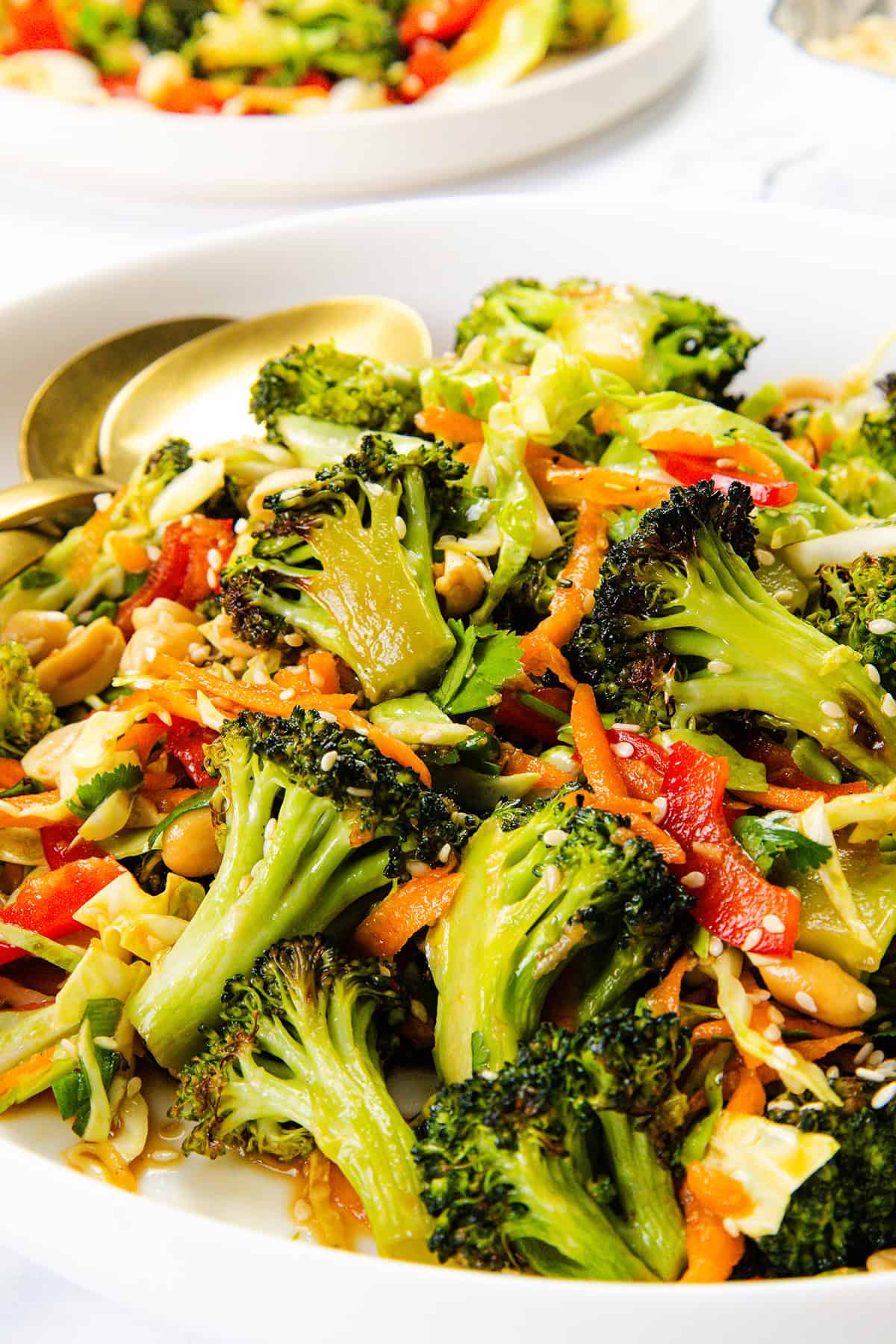


 English (US) ·
English (US) ·